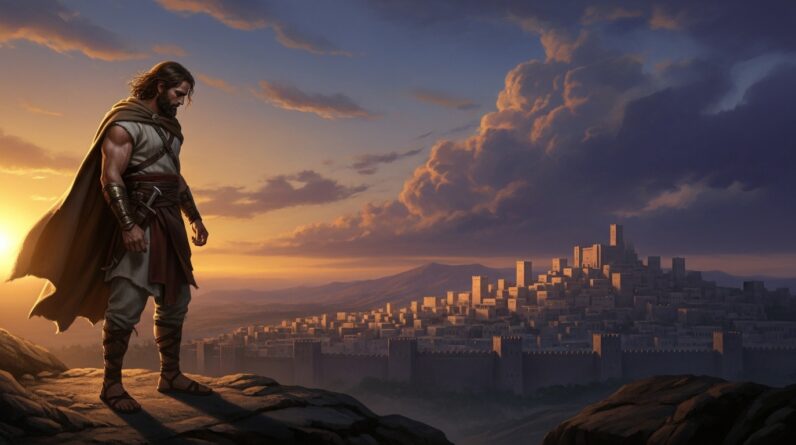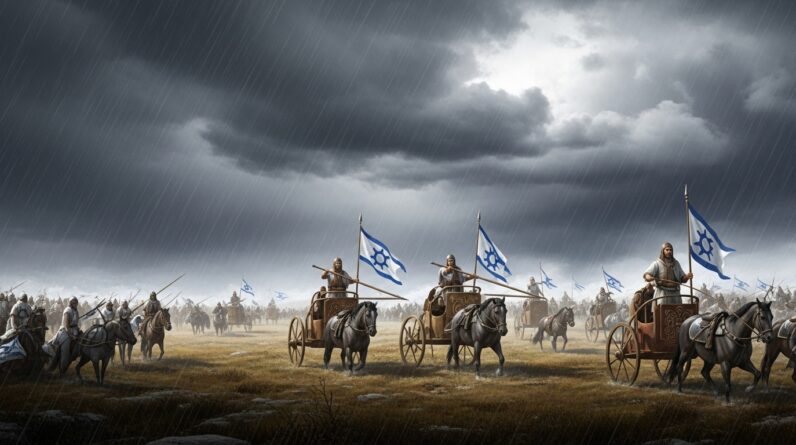Moses And The Red Sea – Faith That Walked Through The Impossible
You’ve probably heard the story a hundred times: a people trapped between Pharaoh’s army and a vast sea, a leader raised by God, and an impossible way made where there seemed to be no way. That moment in Exodus changed the trajectory of Israel, and it still speaks directly to your life today. You’re going to walk through the narrative, the faith that made the miracle possible, and the practical ways you can apply that faith when your own Red Sea appears. Along the way, you’ll see how Moses trusted God and how your faith can move with him through the impossible.
The Historical and Spiritual Context of Exodus 14
Before you can understand what happened, you need to understand where Israel was coming from. The people had been enslaved in Egypt for centuries. God raised up Moses to lead them out, and after the ten plagues, Pharaoh finally let them go. But Pharaoh changed his mind and pursued them. What you’re looking at in Exodus 14 is not just a military standoff; it’s the intersection of human fear and divine deliverance. See the prayerful courage Moses modeled when confronted with danger in Exodus 14:13-14, where Moses tells the people not to be afraid and promises that God will fight for them.
When you read the passage carefully, you’ll notice God’s purposes are both immediate and long-term. The sea-parting is an immediate rescue. The bigger picture is a God who demonstrates His power so that the whole world—and especially the people of Israel—might know He is Lord. That spiritual context should shape how you see your own trials: they’re not just problems to solve; they’re opportunities for God to show Himself faithful.
The Panic and the Promise at the Sea
You can picture the scene: the people camped by the sea, panic rising as Pharaoh’s chariots approached. You’ve been there—cornered by circumstances, heart racing, options dwindling. That’s when Moses does what leaders of faith do: he turns the people toward God and speaks His promises. In Exodus 14:13-14, Moses says, “Do not be afraid. Stand firm and you will see the deliverance the Lord will bring you today.” That’s not cheap optimism; it’s a summons to trust in God’s presence and power.
When Moses spoke, he redirected fear into obedience. He didn’t deny reality—he acknowledged the threat—but he refused to let fear define the narrative. That’s a crucial point for you: faith doesn’t ignore danger; it faces it with God’s promises. Remember that God often meets you not by removing the difficulty immediately, but by giving you a new posture toward it.
Moses’ Leadership: Boldness Rooted in God
Leadership in times of crisis often reveals what’s in your heart. Moses could have panicked, fled, or tried to bargain with Pharaoh. Instead, he stood before the people and the threat and obeyed God’s command to lift his staff. That physical act—an outward sign of faith—meant he was not acting in his own strength but representing God’s authority. In Exodus 14, you see leadership that models trust rather than demands it.
You’re called to lead in your sphere the same way. Whether you’re leading a family, a team at work, or yourself through a season of doubt, your courage matters. When you act from the conviction that God is with you, other people will be encouraged to follow. Moses’s leadership was a conduit for God’s power, and your leadership can be the same when it’s humbly surrendered to God.
The Miracle of the Parting: How God Works
When God acted, He did so in a way that removed all human explanation. The waters of the sea were divided, and the Israelites walked on dry land. That’s the moment you call a miracle. But notice how the miracle was tied to obedience: God told Moses to stretch out his hand over the sea (Exodus 14:21-22). What looks like a single instant is actually a partnership—God’s power and human faith cooperating.
When you ask God for a miracle, expect both divine action and a call to obey. Sometimes obedience looks like an act of faith that seems small—a prayer prayed, a door knocked on, a step taken—yet it lines up with God’s will to release His power. Remember: you don’t manufacture the miracle; you position yourself to receive it by responding to God’s voice.

Crossing on Dry Ground: Faith in Motion
You see the result in Exodus when the Israelites walked through the sea on dry land. That physical crossing symbolizes the inner movement of faith—you don’t just believe; you step forward. Hebrews underscores this when it says that by faith the people passed through the Red Sea as if on dry land. Read Hebrews’ reflection on that moment in Hebrews 11:29. The author of Hebrews connects the event to a long line of faithful acts, urging you to see this as part of spiritual history.
When Moses crossed the Red Sea, it wasn’t just a historical footnote. It became a pattern: when you trust God in impossible circumstances, He makes a way. Faith must be acted upon. Your prayers are important, but your steps—small, obedient movements—are often the language God uses to release His deliverance.
The Aftermath: Worship and Witness
After the crossing, the people sang. Moses and Miriam led a song of praise that celebrated God’s power and faithfulness. The rescue didn’t end in relief; it resulted in worship and testimony. The story in Exodus doesn’t stop at survival; it moves to praise and proclamation. For the Israelites, the miracle became a witness to nations and to future generations.
You can’t experience God’s deliverance and stay silent. Your testimony becomes a tool of evangelism and encouragement. When others see how you walked through your impossible moment because of God, they’re invited to trust. The praise that follows deliverance strengthens your faith and spreads hope.
Hebrews’ Reflection: Faith Interprets History
Hebrews looks back at Exodus and interprets it theologically. The writer places the crossing alongside other acts of faith to teach you how to live. Hebrews 11:29 specifically says, “By faith the people passed through the Red Sea as on dry land” (Hebrews 11:29). That’s not just an account; it’s an interpretation: what happened was the fruit of faith.
When you study such passages, you’re invited to see your life as part of a larger faith story. The heroes in Hebrews are not perfect people but people who trusted God amid risk. That perspective permits you to be imperfect yet obedient, to fail and get back up, and to keep walking in trust because God honors faith.
Moses Crossed the Red Sea: The Moment of Decision
At a certain point, you have to decide. For the Israelites, the decision was a physical step into the sea. For you, it might be a spiritual decision—choosing to obey when fear tempts you to stay put. The truth is this: Moses crossed the Red Sea once the command was given and obedience followed. That step of trust is what turned a promise into reality for Israel, and it will do the same for you.
If you’re waiting for conditions to be perfect, this account challenges you. Often, God’s timing asks you to move before everything looks right. Your step—however small—can trigger God to open a path. The moral is clear: faith without action leaves you on the shore; faith in motion becomes a testimony.
Moses Crossed the Red Sea: What This Means for Your Life
This story isn’t merely ancient history; it’s a blueprint. When Moses crossed the Red Sea, it validated God’s promise, revealed God’s power, and produced worship. For your life, that pattern translates into a sequence: receive God’s promise, obey in faith, experience God’s power, then worship and witness. Apply that pattern to any “impossible”—be it a relationship that feels beyond repair, a financial crisis, a health scare, or a vocational shift.
You’re invited to trust that God’s presence in your crisis is as real as it was in theirs. Start by anchoring your hope not in the absence of trouble but in God’s character. Then take the next obedient step He asks of you. Your story can become a modern echo of Moses’ leadership and God’s miraculous ways.
Practical Steps: How to Walk Through Your Red Sea
You need practical steps—something you can do today to move toward God’s deliverance. Faith is not vague; it has actionable dimensions. Here are a few simple steps to help you translate belief into movement:
- Pray specifically and persistently: name the problem and ask God to reveal the next step.
- Obey one small prompt: a phone call, a visit, a prayer, a confession—do it.
- Gather with God’s people: community will sustain you.
- Remember past faithfulness: rehearse what God has done to renew your courage.
These steps turn theology into a life lived. When Moses crossed the Red Sea, it was the result of God’s command and Israel’s obedience. You’ll find that when you follow these practical steps, God often meets you in supernatural ways.
Moses Crossed the Red Sea: The Role of Prayer and Obedience
Prayer and obedience work together. Moses prayed and then obeyed God’s instruction to lift the staff. Your prayers should move you to action, and your actions should be bathed in prayer. Too often, people treat prayer as a passive wish list or obedience as mere checklist behavior. In the Exodus account, they function as two sides of the same coin.
You’ll also notice that obedience is rarely the last step; it’s usually the first spiritual leverage point. When you obey in the small things, you prepare yourself to receive the larger miracles God wants to do. So if you’re waiting for a breakthrough, start with obedience where you can. It positions you to see God’s power in unexpected places.
Moses Crossed the Red Sea: Dealing with Doubt and Fear
You will encounter fear and doubt. The Israelites faced terror and uncertainty, and many of them complained even after seeing miracles. That’s a human response. What you do with fear matters. Do you let it paralyze you, or do you let it propel you toward God? The answer is in choosing trust over anxiety, repeatedly, day by day.
When doubt comes, rehearse God’s promises and remember His past faithfulness. Speak truth into your fear—out loud if you must—and take one obedient step. Sometimes faith feels like a muscle: the more you use it, the stronger it becomes. Give your faith opportunities to grow, even in small ways, and God will honor that growth.
Moses Crossed the Red Sea: Community and Leadership
Leadership isn’t solitary. Moses didn’t lead Israel alone; he had help from Aaron, Miriam, and the people. He also depended on God’s presence. Isolation makes faith harder. You need people who will encourage you, pray with you, and sometimes correct you. When you’re facing your Red Sea, gather allies who will stand with you and lift their voices to God.
If you’re in a season of leadership, remember to pastor your people like Moses did—by modeling trust, pointing to God’s promises, and inviting others to follow. When the community’s faith rises, God’s power is often made visible. Don’t try to carry your trial alone; you were designed for connection.

Moses Crossed the Red Sea: Long-Term Lessons for Your Spiritual Life
This event teaches you to see your spiritual life as a journey of ongoing trust. The crossing wasn’t the end—it led to long wilderness wandering and ongoing dependence on God. That’s important: deliverance doesn’t always mean comfort forever. Often, it means a new season of learning. The lessons you learn while crossing will serve you long after the sea is behind you.
So adopt a long-view spiritual perspective. Celebrate deliverance, but also commit to ongoing discipleship. Growth happens in the seasons after God delivers you, as you learn to walk with Him in new ways and carry His testimony to others.
Common Questions and Honest Answers
You might have questions: Why did God let Egypt pursue Israel? Why did God allow hardship before victory? These are fair questions and reflect a mature faith that wants to understand. Sometimes trials refine your faith—they reveal what you trust most. God’s ways are not always easy to explain, but they are always aimed at producing lives that reflect His glory.
Honest engagement with Scripture and community will help you wrestle with these questions. Seek counsel from mature believers, study the biblical text, and pray for wisdom. The story of Israel at the Red Sea is both a comfort and a challenge: God rescues, but He also teaches. Be willing to be shaped by what you learn.
Practicing This Faith Daily
Faith that walked through the impossible is not just for occasional crises; it’s for daily life. You’ll practice faith by making small choices that reflect trust: confessing need, asking for help, taking responsibility, forgiving others, and giving generously. Those daily practices form the habits that prepare you for bigger miracles.
When Moses crossed the Red Sea, his walk of faith had been formed over years—through God’s call at the burning bush, the plagues, and the persistent leadership required in the wilderness. Your big moments will likewise be the fruit of everyday faithfulness. Make your daily decisions count toward the life God is shaping in you.
Moses Crossed the Red Sea: Your Next Step
What’s your next step? God may be inviting you to a single act of obedience that will change everything. Maybe you need to forgive someone, leave a job, start a ministry, or simply take a step of faith in prayer. Don’t wait for perfect clarity; God often asks you to move before you see the whole staircase. Make one concrete, measurable step this week in response to what God is telling you.
Write it down, tell a trusted friend, and follow through. When Moses crossed the Red Sea, a physical action aligned with God’s command made the miracle possible. Your next obedient step can open the way for God to move in your life, too.
Conclusion: Faith That Walked Through the Impossible
The Red Sea story is not merely a tale of ancient deliverance; it’s an invitation to you. When Moses crossed the Red Sea, God’s presence, Moses’ obedience, and the people’s faith converged to create a miracle. Your life will see a similar convergence when you place God at the center, obey His voice, and step out in faith. Don’t let fear anchor you to the shore. Let God’s promises propel you into the path He’s already preparing.
Let this narrative encourage you today: God is with you in the impossible, and He specializes in making ways where no way seems possible. Trust Him, act in obedience, gather in community, and worship Him when He brings you through. Your story of deliverance can inspire others—just as Israel’s crossing has inspired generations.
Explore More
For further reading and encouragement, check out these posts:
👉 7 Bible Verses About Faith in Hard Times
👉 Job’s Faith: What We Can Learn From His Trials
👉 How To Trust God When Everything Falls Apart
👉 Why God Allows Suffering – A Biblical Perspective
👉 Faith Over Fear: How To Stand Strong In Uncertain Seasons
👉 How To Encourage Someone Struggling With Their Faith
👉 5 Prayers for Strength When You’re Feeling Weak

📘 Jesus and the Woman Caught in Adultery – Grace and Mercy Over Judgement
A powerful retelling of John 8:1-11. This book brings to life the depth of forgiveness, mercy, and God’s unwavering love.
👉 Check it now on Amazon
As a ClickBank Affiliate, I earn from qualifying purchases.
Acknowledgment: All Bible verses referenced in this article were accessed via Bible Gateway (or Bible Hub).
“Want to explore more? Check out our latest post on Why Jesus? and discover the life-changing truth of the Gospel!”








